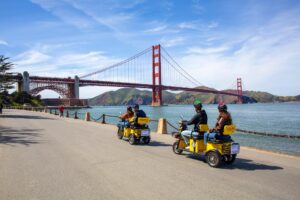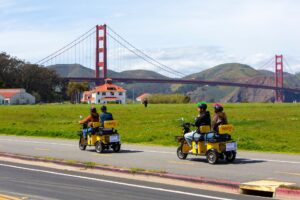Exploring the Palace of Fine Arts in San Francisco
The Palace of Fine Arts in San Francisco is a captivating structure with a rich history, architectural influence, and a story of resilience. Let’s delve into the fascinating details of this iconic landmark.
History and Architectural Influence
The Panama-Pacific International Exposition
- The Palace of Fine Arts was built for the 1915 Panama Pacific Exhibition held in San Francisco, California.
- This exposition played a significant role in reviving the city after the devastating 1906 earthquake and fire.
- It was a grand event that boosted the morale of the Bay Area and helped the city recover economically.
Architectural Vision by Bernard Maybeck
- Bernard Maybeck was the visionary architect behind this masterpiece.
- He designed the Palace to serve as a tranquil zone amidst the bustling fairgrounds, where visitors could appreciate art and sculptures.
- Maybeck drew inspiration from Roman and Ancient Greek architecture, as well as artistic works like Piranesi’s etching and Böcklin’s symbolism painting.
A Faux Ruin
- The Palace was conceived as a fictional ruin from another time, evoking a sense of ancient grandeur.
- It featured a 162-foot-high open rotunda enclosed by a lagoon and a large exhibition center, all surrounded by colonnades.
Saving the Palace
Fragile Beginnings
Temporary Nature
- The Palace of Fine Arts was initially designed to be a temporary structure meant to stand only for the duration of the Panama-Pacific International Exposition in 1915.
- The Palace of Fine Arts was one of ten palaces at the heart of the Panama-Pacific Exhibition. The exhibition also included the exhibit palaces of Education, Liberal Arts, Manufactures, Varied Industries, Agriculture, Food Products, Transportation, Mines, and Metallurgy, and the Palace of Machinery.
- In the spirit of the fair, it was constructed with the expectation that it would serve its purpose for the event and then be dismantled.
Construction Materials
- The colonnade and rotunda, integral parts of the Palace, were not built using durable materials.
- Instead, they were framed in wood and then covered with staff, a combination of plaster and burlap-type fiber.
- While this construction method allowed for a visually appealing appearance, it lacked the longevity needed for a permanent structure.
The Palace Preservation League
- The Palace of Fine Arts was so beloved that the Palace Preservation League was founded during the fair itself to save it from demolition.
Repurposing and Restoration
- Over the years, the Palace had various uses, including hosting art exhibits, and tennis courts, and even serving as military storage during World War II.
- In 1964, the original structure was completely demolished due to its deteriorating condition.
- It was then reconstructed in permanent materials, including concrete and steel, ensuring its longevity.
- The restoration efforts also included replicating the original decorations and sculptures.
Fun Facts about the Palace
Here are 12 fun facts that make the Palace of Fine Arts even more intriguing:
- The Palace has appeared in numerous films, including “Vertigo,” “Time After Time,” and “The Rock.”
- Lucasfilm headquarters in the area draws inspiration from the Palace and resembles Theed on Naboo from “Star Wars: Episode I.”
- The Palace was featured in the video game SimCity 4 as a landmark.
- It was also replicated at Disney’s California Adventure as part of the entrance to a theater showcasing California’s history.
- During the Great Depression, artists were commissioned to replace the decayed murals on the rotunda’s ceiling.
- In 1969, it became home to the Exploratorium interactive museum.
- The Palace of Fine Arts Theater, with 966 seats, opened in 1970.
- In 2003, a public-private partnership was formed to restore and seismically retrofit the Palace.
- It served as the backdrop for scenes in the Indian films “My Name is Khan” and “Vaaranam Aayiram.”
- Wheel of Fortune taped shows at the Palace in both 1992 and 1996.
- In April 2020, there were plans to convert it into a temporary homeless shelter during the coronavirus epidemic, but this decision was later reversed due to protests.
- The lagoon area around the Palace is home to various wildlife, including swans, ducks, geese, turtles, frogs, and raccoons.
Visiting the Palace Today
- Today, the Palace stands as an extravagant neoclassical icon, surrounded by an idyllic pond.
- It remains a popular spot for wedding photos, fashion shoots, and Instagram-worthy moments.
- The Palace is also used as a venue for events, including weddings and trade fairs.
When you visit San Francisco, don’t miss the chance to explore the enchanting Palace of Fine Arts, a testament to architectural beauty, historical significance, and the spirit of preservation. It’s a must-see attraction that continues to captivate visitors from around the world.
Infomation provided by Wikipedia





